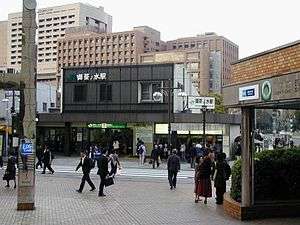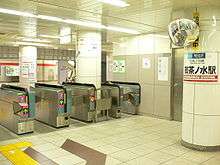Ochanomizu Station
Ochanomizu Station 御茶ノ水駅 | |
|---|---|
 JR East Ochanomizu Station and Tokyo Metro Shin-ochanomizu station entrances | |
| Location |
2 Kanda-Surugadai (JR East), Chiyoda, Tokyo (東京都千代田区神田駿河台2丁目) Japan |
| Operated by | |
| Line(s) | |
| Other information | |
| Station code |
|
| History | |
| Opened | 31 December 1904 |
| Traffic | |
| Passengers (JR East, FY2013) | 104,737 daily |
| Location | |
 Ochanomizu Station Location within Japan | |
Ochanomizu Station (御茶ノ水駅 Ochanomizu-eki) is a railway station in Chiyoda, Tokyo, Japan, operated by East Japan Railway Company (JR East) and the Tokyo subway operator Tokyo Metro.
Location
JR East's Ochanomizu station lies next to the Kanda River. During the Edo period, the Kanda River was rerouted to pass through Ochanomizu, which was otherwise a highland between two valleys. Hijiribashi (聖橋, also known as Hijiri Bridge, Hijiribashi Bridge) crosses over the river near a station exit. The subway Marunouchi Line makes a short above-ground appearance as it passes over the river. Holy Resurrection Cathedral (Nicholai-dō) is easily accessible from the Hijiribashi Exit of this station. The Ochanomizu neighborhood is known for its many guitar and instrument shops.
The Tokyo Metro station is located in Bunkyō Ward, separate from the JR East station, and is served by the Marunouchi Line. The area is also served by the Chiyoda Line at Shin-Ochanomizu, which is connected to Ogawamachi station on the Toei Shinjuku Line.
Station layout
JR East
The JR East portion of the station has two island platforms serving four tracks.[1] Tracks 1 and 4 (the outer tracks) serve trains on the Chūō Line (Rapid) whilst tracks 2 and 3 are used by trains on the Chūō-Sōbu Line.[1]
Platforms
| 1 | ■ Chūō Line | for Shinjuku, Tachikawa and Takao |
| 2 | ■ Chūō-Sōbu Line | for Shinjuku, Nakano and Mitaka |
| 3 | ■ Chūō-Sōbu Line | for Kinshichō, Funabashi and Chiba |
| 4 | ■ Chūō Line | for Tokyo |
There are two exits from Ochanomizu to street level. The larger of the two is the Ochanomizu-bashi exit on the western end of the station which features ticket vending machines, a JR reservation office, toilets, and lockers. The other is the Hijiri-bashi exit which only has ticket vending machines and toilets.[1]
Ochanomizu is the second stop after Tokyo Station on the Chūō Line and one stop before Akihabara Station when travelling from Shinjuku.
Tokyo Metro

The Tokyo Metro station consists of two side platforms serving two tracks.[2]
Platforms
| 1 | ○ Tokyo Metro Marunouchi Line | for Tokyo, Ginza, Shinjuku and Ogikubo |
| 2 | ○ Tokyo Metro Marunouchi Line | for Kōrakuen and Ikebukuro |
Adjacent stations
| « | Service | » | ||
|---|---|---|---|---|
| Chūō Line (JC03) | ||||
| Kanda (JC02, KND) | Commuter Special Rapid | Yotsuya (JC04) | ||
| Kanda (JC02, KND) | Chūō Special Rapid | Yotsuya (JC04) | ||
| Kanda (JC02, KND) | Ōme Special Rapid | Yotsuya (JC04) | ||
| Kanda (JC02, KND) | Commuter Rapid | Yotsuya (JC04) | ||
| Kanda (JC02, KND) | Rapid | Yotsuya (JC04) | ||
| Kanda (JC02, KND) | Local[Note 1] | Suidōbashi (JB17) | ||
| Chūō-Sōbu Line (JB18) | ||||
| Akihabara (JB19, AKB) | Local | Suidobashi (JB17) | ||
| Tokyo Metro Marunouchi Line (M-20) | ||||
| Awajichō (M-19) | - | Hongō-Sanchōme (M-21) | ||
- ↑ Morning and night only
History
The JR East station opened on 31 December 1904.[3] The Tokyo Metro station opened on 20 January 1954.[4]
Passenger statistics
In fiscal 2013, the JR East station was used by 104,737 passengers daily (boarding passengers only), making it the 34th-busiest station operated by JR East.[5] In fiscal 2013, the Tokyo Metro station was used by an average of 55,529 passengers per day (exiting and entering passengers), making it the 66th-busiest station operated by Tokyo Metro.[6] The average daily passenger figures for each operator in previous years are as shown below.
| Fiscal year | JR East | Tokyo Metro |
|---|---|---|
| 1999 | 118,211[7] | |
| 2000 | 116,955[8] | |
| 2005 | 106,967[9] | |
| 2010 | 101,617[10] | |
| 2011 | 100,518[11] | 51,629[12] |
| 2012 | 100,157[13] | 52,642[14] |
| 2013 | 104,737[5] | 55,529[6] |
- Note that JR East figures are for boarding passengers only.
See also
References
- 1 2 3 Ochanomizu station map JR East Retrieved on 13 January 2009
- ↑ Ochanomizu Station diagram Retrieved on 4 September 2009. (Japanese)
- ↑ JR East station information Retrieved on 4 September 2009. (Japanese)
- ↑ Terada, Hirokazu (July 2002). データブック日本の私鉄 (Databook: Japan's Private Railways). Japan: Neko Publishing. p. 213. ISBN 4-87366-874-3.
- 1 2 各駅の乗車人員 (2013年度) [Station passenger figures (Fiscal 2013)] (in Japanese). Japan: East Japan Railway Company. Retrieved 12 September 2014.
- 1 2 各駅の乗降人員ランキング [Station usage ranking] (in Japanese). Tokyo Metro. Retrieved 12 September 2014.
- ↑ 各駅の乗車人員 (1999年度) [Station passenger figures (Fiscal 1999)] (in Japanese). Japan: East Japan Railway Company. Retrieved 12 September 2014.
- ↑ 各駅の乗車人員 (2000年度) [Station passenger figures (Fiscal 2000)] (in Japanese). Japan: East Japan Railway Company. Retrieved 12 September 2014.
- ↑ 各駅の乗車人員 (2005年度) [Station passenger figures (Fiscal 2005)] (in Japanese). Japan: East Japan Railway Company. Retrieved 12 September 2014.
- ↑ 各駅の乗車人員 (2010年度) [Station passenger figures (Fiscal 2010)] (in Japanese). Japan: East Japan Railway Company. Retrieved 12 September 2014.
- ↑ 各駅の乗車人員 (2011年度) [Station passenger figures (Fiscal 2011)] (in Japanese). Japan: East Japan Railway Company. Retrieved 12 September 2014.
- ↑ 駅別乗降人員順位表(2011年度1日平均) [Station passenger figures (Fiscal 2011)] (in Japanese). Japan: Tokyo Metro. Retrieved 12 September 2014.
- ↑ 各駅の乗車人員 (2012年度) [Station passenger figures (Fiscal 2012)] (in Japanese). Japan: East Japan Railway Company. Retrieved 12 September 2014.
- ↑ 各駅の乗降人員ランキング (2012年) [Station usage ranking (2012)] (in Japanese). Tokyo Metro. Retrieved 12 September 2014.
External links
| Wikimedia Commons has media related to Ochanomizu Station. |
- JR East station information (Japanese)
- Tokyo Metro station information (Japanese)
Coordinates: 35°41′59″N 139°45′50″E / 35.69972°N 139.76389°E